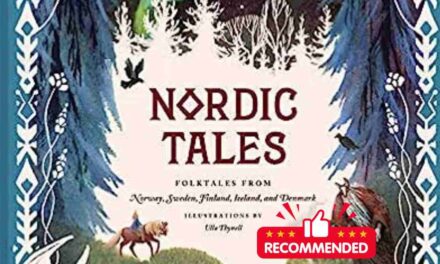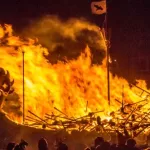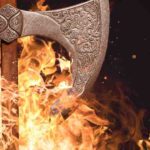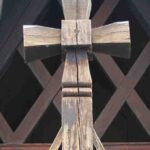The authentic history begins with Halfdan the Swarthy, or Halfdan the Black, who reigned from about the year 821 to about 860. The Icelander Snorre Sturlason, who, in the twelfth century, wrote the “Heimskringla,” or the Sagas of the Norse Kings, gives a long line of preceding kings of the Yngling race, the royal family to which Halfdan the Swarthy belonged; but that part of the Saga belongs to mythology rather than to history.
According to tradition the Yngling family were descendants of Fiolner, the son of the god Frey. One of the surnames of the god was Yngve, from which the family derived the name Ynglings. Their original home is said to have been Upsala in Sweden, but they were driven away on account of their cruelty. One of them, whose name was Olaf, emigrated with his followers to Vermeland, which he made habitable by cleaning away a great deal of the timber. Hence he was called Olaf the Tree-feller (Tre-telgja). His son, Halfdan Whiteleg (Hvitbein), conquered Romerike and other Norwegian districts, and Halfdan’s son also became king of Vestfold, or the country west of the Folden, the bay now called the Christiania Fjord. Vestfold now became the most important part of the country. In the neighborhood of the present town of Laurvik a famous temple was founded in Skirings-sal, where the kings often resided, and which soon became a popular trading place.
Halfdan Whiteleg’s grandson, Gudrod the Hunter, made war on Harald Redbeard, who was king of Agder, the southwestern part of Norway. He killed Harald and his son Gyrd, and took a great booty. He afterward married Harald’s daughter, Asa.
Gudrod’s son, Halfdan, surnamed the Swarthy, was only a year old when his father was killed, and his mother Asa then returned with him to Agder, where he grew up and became stout and strong. At the age of eighteen he became king in Agder, and soon afterward went to Vestfold, where he divided that kingdom with his brother Olaf. Halfdan increased his possessions, both by marriage and by warfare, until he ruled over the whole country around the Christiania Fjord, Thoten, Land, Hadeland, Romerike and Sogn. King Halfdan was a wise man, a lover of truth and justice. He made good laws, which he observed himself and compelled others to observe. He fixed certain mulcts, or penalties, for all crimes committed. His code of laws, called the Eidsiva Law, was adopted at a common Thing at Eidsvold, where about a thousand years later the present constitution of Norway was adopted.
Halfdan became the ancestor of the royal race of Norway, his son, Harald the Fairhaired, being the first king of united Norway. According to tradition, when Queen Ragnhild was with child she dreamed that she was standing in her herb-garden, and she took a thorn out of her chemise, and while she was holding it in her hand it grew into a great tree, one end of which struck roots into the earth, while the other raised itself in the air until she could hardly see the top or the end of its widely spread branches. The lower part of the tree was red with blood, but the stem was beautifully green, and the branches white as snow, and they spread over all Norway, and even much more. This dream was years afterward interpreted as having foretold the destiny of Ragnhild’s son.
One day in the spring of 860, when Halfdan the Swarthy was driving home from a feast across the Randsfjord, he broke through the ice and was drowned. He was so popular that when his body was found the leading men in each Fylki demanded to have him buried with them, believing that it would bring prosperity to the district. They at last agreed to divide the body into four parts, which were buried in four different districts. The trunk of the body was buried in a mound at Stein, Ringerike, where a little hill is still called Halfdan’s Mound. Read next: Harald the Fairhaired (860-930)—Norway United
Author: Sigvart Sörensen





















Trackbacks/Pingbacks